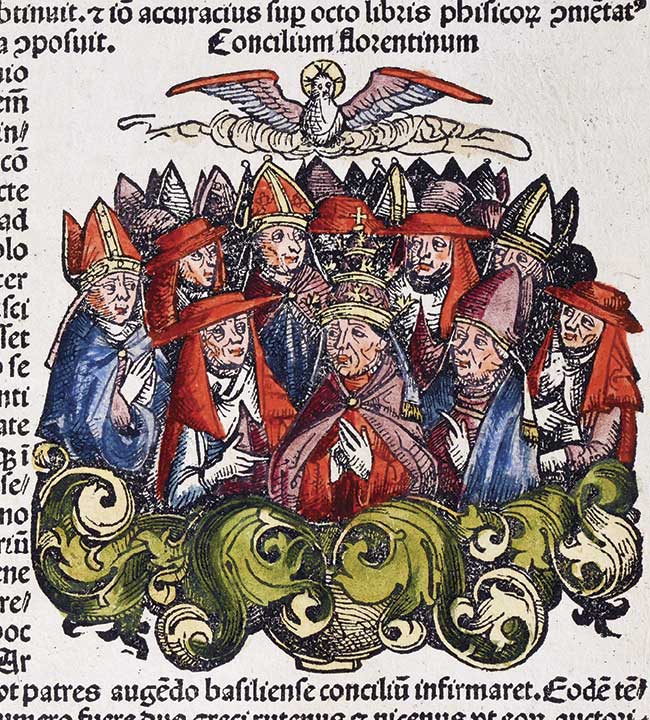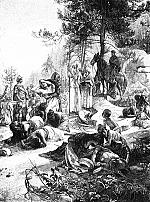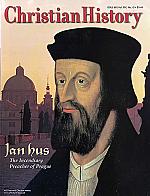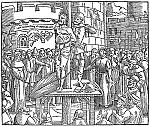Conquests and convents, division and dung

[Michael Wohlgemut, Wilhelm Pleydenwurff and their workshop, Woodcut of The Council of Florence in The Nuremberg Chronicle, 1493. Latin copy in Sao Paulo, Ms. Blatt f. 244v.—Public domain, Wikimedia]
From kings to mendicants, from east to west, the Middle Ages was as deep, varied, and wide as Christendom itself. These selections represent our most-read medieval topics.
Charlemagne vs. the Saxons
Charlemagne (c. 745–814) was tall, handsome, and slightly overweight. He resisted his doctors’ suggestion that it might be better for his health if he ate less roast meat. He enjoyed hunting and riding.
He was, by historical accounts, a confessing, committed Christian ruler. He built a great church to the glory of God at Aachen (Aix-la-Chapelle), ornate with gold, silver, and fine marble brought from Ravenna in Italy. He provided ceremonial vestments for everyone, from priests to doorkeepers. He gave much to those in need at home and also to those abroad. Yet most of his life was spent in expansive warfare. The spoils of war allowed his extravagant generosity to the needy.
Among Charlemagne’s conquests were the Saxons. This group, which had settled in Europe and on the British Isles, spoke the Teutonic language at the root of modern English. Their Frankish conquerors spoke a tongue derived from late Latin. The Saxons on the European continent were still mostly pagans. Anglo-Saxon settlers in Britain had been converted to Christianity by the mission of Augustine of Canterbury, sent from Rome by Pope Gregory the Great at the end of the sixth century.
The Frankish annals that tell the story of 30 years of Saxon wars stress Charlemagne’s determination to remove the cultic symbols of Saxon paganism. But it is hard to say whether the Saxon wars were really driven by the desire to convert the Saxon tribes. A famous massacre at Verden in 782, where an angry Charlemagne is described by the royal Frankish annals as seeking revenge for the killing of some of his nobles in a battle, seems to have been motivated most strongly by the lust for conquest.
Whether the wars began for that reason or not, Charlemagne was later criticized for seeking to convert the Saxons by force. When it was all over, Charlemagne himself published a document setting out the terms of the “Capitulation of the Saxons.” It stated, among other provisions of enforced Christianization, that anyone who refused to be baptized should be put to death.—G. R. Evans, from CH #108
Brides of Christ
Most medieval women married men their families chose for them. If not, many upper-class women of the high and late Middle Ages went peaceably to the convent. Such marriages, to men or to Christ, were reasonably successful. To be Christ’s bride was, for many women, not a denial of the “natural” desire to marry and bear children, but rather the route to a more independent and intellectually creative life. One example is the great Hildegard of Bingen (1098–1179), famed mystic, author, and advisor to popes, kings, and emperors. A frail child, she was dedicated to the church by her family, minor nobles in Rhineland Germany. Nuns lived communally under rule and took the three monastic vows of chastity, poverty, and obedience. Other women often made religious choices in opposition to their families. The following professions were all lives of choice.
Hermits. In the eleventh and twelfth centuries, like many men in this period of religious revival, some women of religious bent rejected the communal and regulated life of the convent for the desolation and difficulty of a solitary life in the wilderness as hermits. Alone or with a small group of like-minded individuals, they lived in makeshift dwellings and sought a mystical relationship with God.
Beguines. The beguine took temporary vows, usually of chastity and simplicity of life, donned some kind of identifying habit, and dedicated herself to good works. A product of the growing cities of thirteenth- and fourteenth-century Europe, she worked in those cities, answering the needs of the displaced poor and sick. She was bound to no order. She might live at home or with a group who shared her values. She could later renounce her vows and marry without difficulty. The beguine movement was the only religious current of the Middle Ages that was female in conception. It swept through the Low Countries and Germany in the thirteenth century and accommodated women of more middling status than those who filled the nunneries.
Tertiaries. Following the success of Francis of Assisi in the early thirteenth century, mendicant communities that begged for a living arose. These quickly organized into three orders. First Orders were the friars themselves—groups of wandering male preachers vowed to absolute poverty and complete dependence upon alms. Second Orders were women in traditional nunneries vowed to obedience who also sought to participate in the friars’ voluntary poverty. Third Orders, tertiaries, were laypeople—male and female, married and single—who in some way identified with the reformist ideals and apostolic fervor of Francis’s early followers. One of the most famous tertiaries was Catherine of Siena (1347–1380).
Anchoresses. Having made the decision to live alone, this solitary woman took vows and forever lived in her cell. Free of rule she was literally enclosed, most often in a room or a little house attached to a church. Common throughout the period from 1100 to 1500, anchoresses were found next to village churches, town chapels, cathedrals, or guild churches in commercial cities. The anchoress practiced total withdrawal and great asceticism, yet she was as at home in the cities of Europe as her forebears had been in the deserts of antiquity. Many women became anchoresses who had been nuns, beguines, or tertiaries. Others became anchoresses directly from lay life, accepting and persevering in this remarkable challenge for 30, 40, even 50 years. Julian of Norwich (c. 1343–c. 1416) lived as an anchoress in the turbulent fourteenth century in a cell attached to St. Julian’s Church in Norwich, England. From her anchorhold she wrote The Revelations of Divine Love, the first English book known to be written by a woman.
While not all were Hildegards or Catherines commanding popes and remonstrating kings and emperors, religious medieval women had a strong sense of identity and purpose and an absolute certainty of the rightness of their relationship with their Savior. To them the nunnery was indeed an earthly paradise.—Ann K. Warren, from CH #30
The Great Schism
On Saturday, July 16, 1054, Cardinal Humbert, legate of Pope Leo IX, strode into the Cathedral of Hagia Sophia, right up to the main altar, and placed on it a parchment that declared the patriarch of Constantinople, Michael Cerularius, to be excommunicated. He then marched out of the church, shook its dust from his feet, and left the city. A week later the patriarch solemnly condemned the cardinal.
Centuries later this dramatic incident was thought to mark the beginning of the schism between the Latin and the Greek churches, a division that still separates Roman Catholics and Eastern Orthodox. But the process leading to the definitive break began well before 1054.
Problems arose in southern Italy (then under Byzantine rule) in the 1040s, when Norman warriors conquered the region and replaced Eastern Greek bishops with Western Latin ones. People argued about the proper form of the liturgy and other external matters. Differences over clerical marriage, the bread used for the Eucharist, days of fasting, and other usages assumed an unprecedented importance.
When Patriarch Cerularius heard the Normans were forbidding Greek customs in southern Italy, he retaliated in 1052 by closing Latin churches in Constantinople and indirectly attacking the Latin use of unleavened bread and other practices. In response Pope Leo sent his chief advisor, Humbert, a tactless and narrow-minded man with a strong sense of papal authority, to Constantinople.
On arriving in the imperial city in April 1054, Humbert launched into a vicious criticism of Cerularius and his supporters. But the patriarch ignored him. Thus an angry Humbert stalked into Hagia Sophia and placed on the altar the bull of excommunication. He returned to Rome convinced he had gained a victory.
Even so the events of 1054 were quickly forgotten. Negotiations between the pope and the Byzantine emperor continued, especially as Byzantines sought aid against invading Turks. In 1095 Pope Urban II helped by proclaiming the Crusades. Despite episodes of tension and conflict, Eastern and Western Christians lived and worshiped together.
In the latter half of the twelfth century, however, friction again increased. Violent anti-Latin riots erupted in Constantinople in 1182, and in 1204 Western knights brutally ravaged Constantinople. The tension accelerated, and by 1234 when Greek and Latin church leaders met to discuss their differences, it was obvious they represented different churches. Arguments over authority complicated matters.
The strengthening of papal authority in the Western church caused it to become more autocratic and centralized. Basing his claims on his succession from St. Peter, the pope asserted direct jurisdiction over the entire church, East and West. But the Byzantines viewed their church in the context of the imperial system; their sources of law and unity were the ecumenical councils and the emperor, whom God had placed over all things, spiritual and temporal. They believed that the Eastern churches had autonomy of governance. They rejected papal claims to absolute rule.
Since the ninth century, theological controversy focused on the procession of the Holy Spirit. In the life of the Trinity, does the Spirit proceed from the Father only, or from the Father and from the Son (filioque in Latin)? The Western church, concerned about resurgent Arianism, had, almost inadvertently, added the word filioque to the Nicene Creed. The Greeks objected to the addition to the creed and the theological proposition involved, which seemed to them to diminish the individual properties of the three Persons in the Trinity. In 1439 Greek and Latin theologians at the Council of Florence, after debating the issue for over a year, arrived at a compromise that, while reasonable, was not fully satisfactory. The Byzantine Empire fell in 1453.
Over the years both Orthodox believers and adherents to Rome have made efforts to address the issues, but have yet to make the necessary concessions. The churches remain separate today.—George T. Dennis, from CH #28
Poverty and dung
An armor-clad knight rode his war charger out of Assisi to battle against his neighboring Italian town of Perugia. When this brave youth, Francesco Bernardone (1181–1226), saw a pitiful leper in the road, he tried to flee. But as he passed, Francis thought he saw Christ in the outcast’s face. He stopped, kissed the leper, gave alms, seated the man on the horse, and led the way to the leper’s destination. Before this Francis had so loathed the sight of lepers that he would look at their houses only from a distance of two miles while holding his nose. But Francis later said,
What had previously nauseated me became a source of spiritual and physical consolation. . . . After that I did not wait long before leaving the world.
For Francis, leaving the world meant caring for lepers and praying in deserted chapels. This fanaticism exasperated Pietro Bernardone, Francis’s wealthy father. He eventually disowned his son. In turn Francis renounced all inheritance rights. Upon abandoning his wealth, Francis determined there must be no man anywhere poorer than he. No matter what rags Francis might be wearing, should he come upon a beggar dressed even worse, Francis would remove his own clothing and give it to the beggar.
Francis told people of Christ in the Italian language, not in ecclesiastical Latin. He wanted to live as Jesus had lived and to preach as Jesus preached. He and those who soon followed him worked in the world to help others, preaching the gospel and caring for the sick and suffering, and giving up everything for Christ. The brothers were not allowed to handle money. They expected to be paid for their work in food and clothing, but if not, they must beg for necessities.
Francis did not permit them to save money or provisions for a rainy day. And he attacked the subtle temptation of pious Christians to hoard wealth under the pretext of beautifying churches or serving God. Francis repeatedly referred to money as “dung” and held that it should be shunned as the devil himself. Consistent with his abhorrence of all things material, Francis taught the brothers to build cheap little houses of wood, not of stone. For example, upon his return to St. Mary of the Portiuncula he discovered a comfortable, newly built home. Thinking that living in such a dwelling would lead to pride, Francis began to dismantle it by tearing slates and tiles from the roof. He was persuaded to stop only when someone explained that the house didn’t belong to his order.
When Francis was sick and dying, the people of Assisi sent knights to bring him back home. Hunger and fatigue halted the party as they came through the poor village of Satriano, but the knights could find no food for sale. They went to Francis and requested a morsel from his alms sack, but the old saint rebuked them for trusting more in their “flies” (another of his terms for money) than in God. They were sent again, this time instructed to offer God’s love in place of money while begging humbly for alms. The knights swallowed their pride, did as Francis instructed, and discovered they could buy more with the love of God than they could with money, for all gave gladly.
Shortly thereafter Francis died. His last words were, “I have done my duty; may Christ now teach you yours.”—Daniel V. Runyon, from CH #14 CH
By G. R. Evans, Ann K. Warren, George T. Dennis, Daniel V. Runyon
[Christian History originally published this article in Christian History Issue #150 in 2024]
G. R. Evans is emeritus professor of medieval theology and intellectual history at the University of Cambridge. Ann K. Warren was an adjunct associate professor of history at Case Western Reserve University. George T. Dennis (1923–2010) was emeritus professor of history at Catholic University of America in Washington. Daniel V. Runyon is a retired university professor of English and communications and a former journalist and magazine editor.Next articles
Moments that mattered
Issues that stood out to previous editors and contributors.
Elesha Coffman, Bill Curtis, David Neff, Jennifer Woodruff Tait,A life of luxury meets the life of Christ
The lives of Christ and the saints filled Ignatius with a sense of “consolation.”
Katie M. BenjaminSupport us
Christian History Institute (CHI) is a non-profit Pennsylvania corporation founded in 1982. Your donations support the continuation of this ministry
Donate







